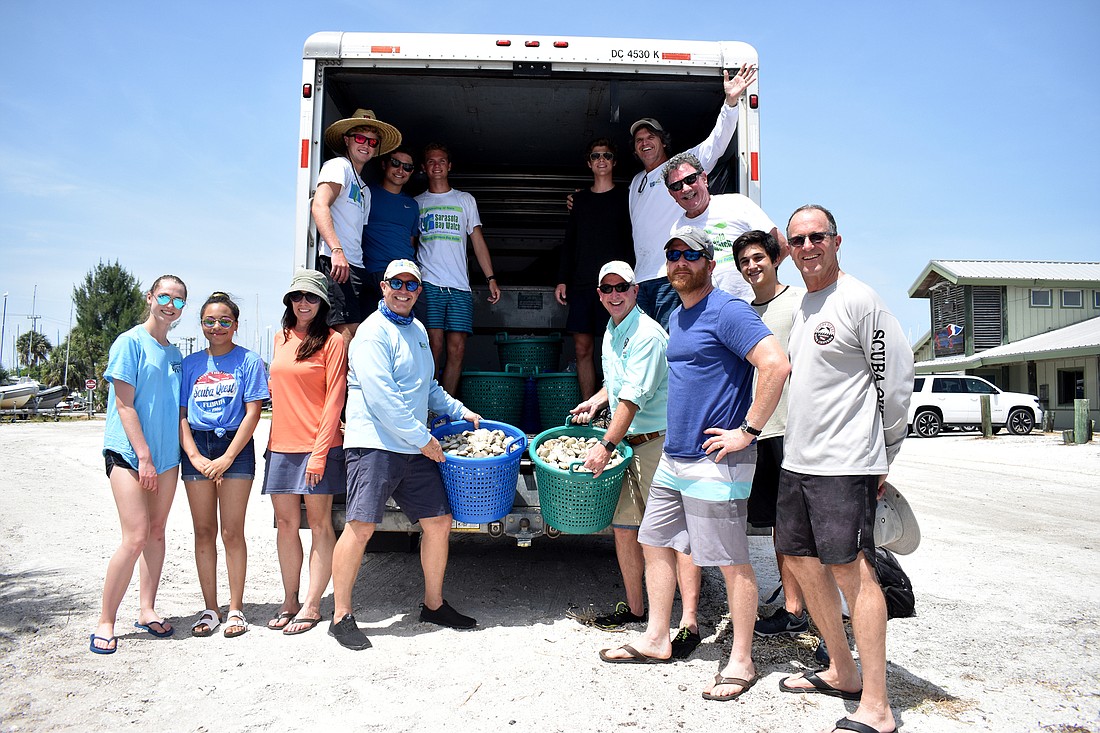- March 11, 2025
-
-
Loading

Loading

In an effort to improve the water quality of Sarasota Bay, the Sarasota Bay Watch has embarked on restoration efforts of southern hardshell clams.
Clams help maintain the health of Sarasota Bay. Florida Fish and Wildlife Conservation Commissioner Michael Sole said before human intervention in a lot of the bays up and down Florida’s coast, there were significantly more clams. Even from a commercial standpoint, the presence of clam’s has decreased. Now, not only should clams be restored from a commercial standpoint, he said, but also from an ecological standpoint.
“Here, we have a keystone species that is kind of the base of some of our ecological health of the bay,” Sole said. “We’ve lost a lot of these animals from an abundance standpoint, so restoring that abundance in the bay is envisioning to actually help restore water quality as well as kind of get us back to a balance.”
On June 16, Bay Watch members and volunteers released 30,000 clams into the bay waters. This brings the total release number to 125,000, which puts them at the halfway mark to their goal of 210,000-250,000.
Sarasota Bay Watch, which obtained a permit from the state for this project, has a partnership with Bay Shellfish Co., a professional shellfish hatchery in Terra Ceia. In late 2016, the company conditioned and spawned the native adult clams for the Bay Watch. In March 2017, Bay Watch purchased 330,000 seed clams, which were about the size of fingernails, Sarasota Bay Watch President Larry Stults wrote in an email.
As the clams grew, 310,000 survived and 250,000 of them were transferred to a second farmer while 60,000 were dispersed in seagrass beds in Sarasota Bay.
Despite Hurricane Irma, more than 200,000 of the 250,000 farmed and released clams survived and grew to top neck size, which is about 2.5 inches. Top neck size is preferred for the project because at that size the clams are large enough and their shells are thick enough to be fairly resistant to predators.
Now, the clams from the aqua-farmer are making their way to Sarasota Bay. Each harvest, of which there will be seven by the time the project is finished, contains 3,000 pounds of clams.
The clams can live in shallow water, grass beds, deeper water or on sandy bottoms. Sarasota Bay Watch’s strategy is to basically hide the clams.
Clams are placed in deeper water so they are farther from the likelihood of poaching. If humans find them, Stults said, they’ll pick them up even if they are not in approved harvesting areas.
Clams are placed in sandy bottoms instead of seagrass. At the size of these clams, it’s more difficult for them to burrow in the roots of seagrass.
By the time the group has finished the restoration project, 18 months will have passed and $20,000 will have been spent.
“The thing about clams is, they’re a wonderful filter feeder. That’s exactly one of the issues that we face in a lot of our water bodies ... trying to address where it’s increased nutrient load, algal growth,” Sole said. “Clams, oysters, as Larry points appropriately, even scallops have tremendous filter feeding capability and actually can clean the water.”
Mote Marine Laboratory scientists, another partner in the project, have created experimental quadrants around the clam release areas to test variables such as hand planting versus dropping clams, cover netting versus none and grassy versus sandy bottoms.
Re-establishing clams in the bay can help reduce red tide levels, Stults said in his email. The Southern hardshell clams are resistant to red tide and can actually consume the organism, Karenia brevis.
“From an environmental point of view, these clams once were abundant in our local waters, and they should be again to help rebuild and fortify the bay’s ecosystem,” Stults wrote in his email.
“Bringing back clam populations also provides an excellent source of food to support tourism and quality of life issues, so clam restoration also plays a role in boosting our local economy.”